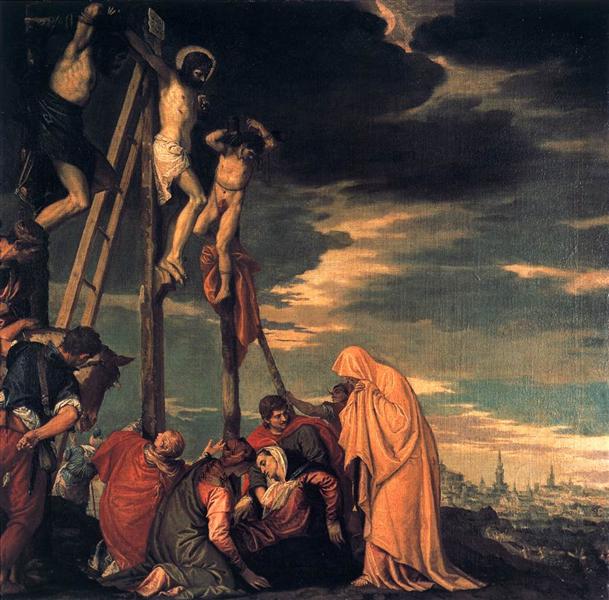Opis
Paolo Veronese's 1582 painting "Crucifixion" is part of the highly vibrant and dramatized art of the late Renaissance, where the emotionality of religious scenes becomes a primary vehicle for transmitting faith to the viewer. Veronese, known for his mastery in the use of color and composition, approaches the theme of the crucifixion in a monumental manner, displaying his talent for creating images that not only fascinate the eye, but also stir the soul.
In the painting, the figure of Christ on the cross stands at the centre of the composition, dominating the scene with a presence that is both powerful and docile. His body, raised on a cross that seems to defy gravity, is depicted with an exquisite sense of proportion and anatomy, characteristics that reflect the influence of the study of the human figure in Veronese's work. The arrangement of the arms, extended in a cross, and the gesture of the face convey both suffering and resignation.
The use of color in this painting is particularly notable. Veronese employs a rich, luminous palette, where reds and golds intertwine to envelop the figure of Christ in a sort of sacred halo. This choice of color not only highlights the central figure, but also contributes to creating an atmosphere of reverence around the crucifixion. In the upper corners, he sculpts an icy sky that emphasizes the separation between the divine and the earthly, a recurring element in his works that appeals to the transcendence of spiritual experience.
In addition to Jesus, other characters appear in the composition, although in a secondary role. Among them we can identify figures that seem to represent Mary and other mourners, clearly affected by the event of the crucifixion. Veronese contextualizes the pain of these characters through their expressions, which adds a layer of emotionality to the scene. Through their gestures, the viewer can feel the weight of shared suffering, which amplifies the experience of the painting.
Veronese's style, renowned for its elaborate compositions and attention to detail, is evident in the carefully organized arrangement of the figures. Despite the gravity of the subject, Veronese manages to infuse the scene with an almost dynamic rhythm, guiding the viewer's gaze from one character to another, creating a visual dialogue that invites contemplation. In this sense, the "Crucifixion" reflects the master's ability to transform a tragic narrative into a richly nuanced visual spectacle.
The work also stands in a tradition of depictions of the crucifixion that have been explored by other contemporary and earlier artists, as well as in the context of religious art of the period. Veronese's ability to innovate within this tradition is noteworthy; his monumental and colourful approach therefore brings a distinctive nuance to the iconography of the subject, compared to, for example, the more restrained and dramatic depictions of Caravaggio.
In short, "Crucifixion" is a masterpiece that combines technical skill and a deep emotional understanding of the subject. Veronese's ability to marry the majesty of the subject with his distinctive use of color and light creates not only a significant work, but also an enduring testament to the power of art to explore and express the complexities of human faith. The interplay of figures, the treatment of space, and the universal atmosphere of pain highlight Veronese's mastery, confirming his place as one of the great masters of the Renaissance.
KUADROS ©, a famous painting on your wall.
Hand-made oil painting reproductions, with the quality of professional artists and the distinctive seal of KUADROS ©.
Painting reproduction service with satisfaction guarantee. If you are not completely satisfied with the replica of your painting, we will refund 100% of your money.

